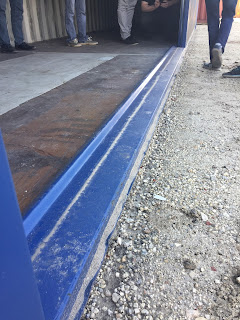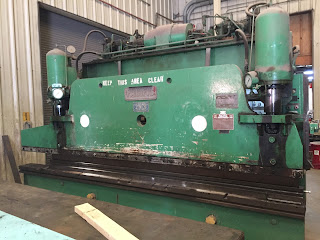CONTAINER DEPOT OBSERVATIONS
 |
One of the first containers we observed was somewhat dilapidated.
|
1. New
2. Cargo Worthy
3. Wind and Water Tight
4. Junk
This one did not appear to be wind and water tight. Although it did have some nice natural day-lighting qualities.
One of the most common types of damage on a shipping container is caused by the forklift blade puncturing the side wall of the container. Other parts of the shipping container that are commonly damaged are the top rails, bottom rails, and the door gaskets.
Shown above is the slot designed for the forklift to use when lifting the container.
The reefer container is engineered so that the refrigerated stock has a constant circulation of cold air around it. The stock is stacked to within a few inches of the top of the container. The cold air passes over the top of the stock and sinks to the base of the container once it reaches the doors. The cold air is then pushed through the channels at the base back to the return intake of the cooling unit.
The reefer container is insulated and uses aluminum which is much lighter that steel for the inner shell. The aluminum is also very resistant to corrosion and oxidation.
The above image shows a very rare 20' open top high cube container.
The second shipping container depot that we visited had several containers that were modified for other purposes. The above container was modified to have a coiling door installed on one side. The corrugated steel was cut out and replaced with a tube steel frame the same size as the door. The frame was welded all the way around to add stability to the opening.
A threshold that was pressed out of sheet steel is used to help prevent water intrusion.
This hydraulic press can be used to form sheets of steel into various profiles using different shape dies.
Con-Global has a state-of-the art facility that was previously owned and operated by the U.S military to repair military equipment such as tanks, boats, and other types of armored vehicles. The image above shows a sand blasting booth that is large enough to fit an entire shipping container inside. The items to be sand blasted are pulled through the booth by a chain pulley system and guided by a track attached to the floor.
A large hoist that runs on tracks spanning the entire warehouse can be used to lift and transport large pieces of heavy steel, equipment, or even entire shipping containers to any point inside the structure.
One container was in the process of being fabricated into an occupiable structure complete with electric, lighting, and air conditioning. The wood framing inside allows for space within the walls for insulation and creates a surface for hanging any building material desired such as plywood, gypsum board, or FRP.













No comments:
Post a Comment
Note: Only a member of this blog may post a comment.